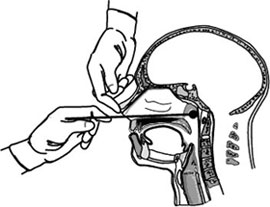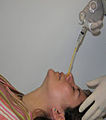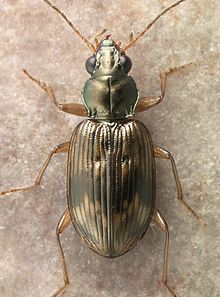나소파린겔 면봉
Nasopharyngeal swab| 나소파린겔 면봉 | |
|---|---|
 나소파린겔 면봉 | |
| 목적 | 특정 바이러스 감염의 진단 |
| 메드라인플러스 | 003747 |
비인두 면봉은 코와 목 뒤쪽에서 비강 분비물 샘플을 채취하는 데 사용되는 장치다.[1][2]그리고 나서 그 샘플은 질병에 대한 유기체나 다른 임상 표지의 존재에 대해 분석된다.이 진단방법은 사스, 메르스, COVID-19 등 코로나바이러스 계열의 바이러스에 의한 백일해, 디프테리아, 인플루엔자, 각종 질환의 의심환자에 주로 쓰인다.[3][4][5][6][7][8]
절차
표본을 채취하기 위해 면봉을 콧구멍에 넣고 입천장을 덮고 있는 인두부 영역인 비인두부로 부드럽게 앞으로 이동시킨다.[9]그런 다음 면봉을 지정된 기간 동안 회전시켜 분비물을 수집한 다음 면봉을 제거하고 멸균 바이러스 전달 매체에 넣어 후속 분석을 위해 샘플을 보존한다.[5][6]
면봉의 재료 구성
면봉과 비슷한 개념으로, 비인두 채집에 사용되는 면봉은 면봉이나 폴리에스테르, 또는 나일론 같은 흡착재로 덮인 짧은 플라스틱 막대로 이루어진 좁은 막대를 구성한다. (일부 면봉 손잡이는 니크롬이나 스테인리스 철사로 만들어졌다.)[3][10]특정 진단 애플리케이션에 사용되는 면봉 재료는 시험 유형에 따라 달라질 수 있다.일부 연구에서는 집적된 면봉이 섬유 면봉에 비해 더 많은 양의 샘플 재료를 수집한다는 것을 보여 주었다.[7][11]
관련 방법
약간 다르지만 연관성이 있는 것은 비인두적 열망이다.비인두에서 물질을 잡기 위해 물리적인 면봉에 의존하기 보다는 흡인력은 주사기에 부착된 카테터를 사용한다.면봉법과 마찬가지로 카테터를 콧구멍에 넣고 약 1~3밀리리터의 식염수가 유입되는 비인두까지 부드럽게 진척시킨 후 즉시 식염수(세포와 분비액과 함께)를 주사기로 다시 재생성한다.[7]이 흡인법은 1. 환자가 유아 또는 노약자일 때, 2. 시험 유형에 효과가 있는 것으로 나타날 때 자주 사용된다.[6][12]
도표
비인두 흡인물 수집
COVID-19용 비인두성 면봉 테스트 영상
참고 항목
참조
- ^ "Nasopharyngeal culture". MedlinePlus. 23 March 2020. Retrieved 25 March 2020.
- ^ Pavord, T.; Pavord, M. (2004). The complete equine veterinary manual: A comprehensive and instant guide to equine health (2nd ed.). David & Charles. p. 206. ISBN 9780715318836.
- ^ a b Junkins, A. (2010). "20. Identification of Pathogenic Bacteria". In Mukherjee, K.I.; Ghosh, S. (eds.). Medical Laboratory Technology. Vol. 2 (2nd ed.). Tata McGraw-Hill. p. 515. ISBN 9781259000768.
- ^ "Specimen Collection". Pertussis (Whooping Cough). Centers for Disease Control and Prevention. 18 November 2019. Retrieved 25 March 2020.
- ^ a b Irving, S.A.; Vandermause, M.F.; Shay, D.K.; Belongia, E.A. (2012). "Comparison of nasal and nasopharyngeal swabs for influenza detection in adults". Clinical Medicine & Research. 10 (4): 215–8. doi:10.3121/cmr.2012.1084. PMC 3494547. PMID 22723469.
- ^ a b c "Influenza Specimen Collection" (PDF). Centers for Disease Control and Prevention. n.d. Retrieved 25 March 2020.
A nasopharyngeal (NP) swab is the optimal upper respiratory tract specimen collection method for influenza testing.
- ^ a b c McPherson, R.A.; Pincus, M.R. (2017). Henry's Clinical Diagnosis and Management by Laboratory Methods (First South Asia ed.). Elsevier. p. 1083. ISBN 9788131231272.
- ^ World Health Organization (19 March 2020). "Laboratory testing for coronavirus disease (COVID-19) in suspected human cases: Interim guidance, 19 March 2020". WHO/COVID-19/laboratory/2020.5. World Health Organization. hdl:10665/331501. Retrieved 25 March 2020.
- ^ Marty FM, Chen K, Verrill KA (28 May 2020). "How to Obtain a Nasopharyngeal Swab Specimen". The New England Journal of Medicine. 382 (22): e76. doi:10.1056/NEJMvcm2010260. PMID 32302471. Retrieved 20 September 2020.
- ^ Gritzfeld, J.F.; Roberts, P.; Roche, L.; et al. (2011). "Comparison between nasopharyngeal swab and nasal wash, using culture and PCR, in the detection of potential respiratory pathogens". BMC Research Notes. 4. 122. doi:10.1186/1756-0500-4-122. PMC 3084159. PMID 21489228.
- ^ Sing, S.K., ed. (2014). Human Respiratory Viral Infections. CRC Press. p. 166. ISBN 9781466583207.
- ^ Nunes, M.C.; Soofie, N.; Downs, S.; et al. (2016). "Comparing the Yield of Nasopharyngeal Swabs, Nasal Aspirates, and Induced Sputum for Detection of Bordetella pertussis in Hospitalized Infants". Clinical Infectious Diseases. 63 (Suppl. 4): S181–S186. doi:10.1093/cid/ciw521. PMC 5106614. PMID 27838671.








